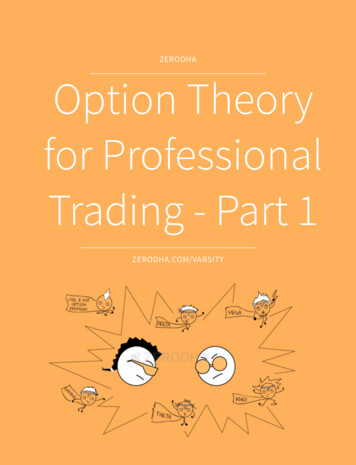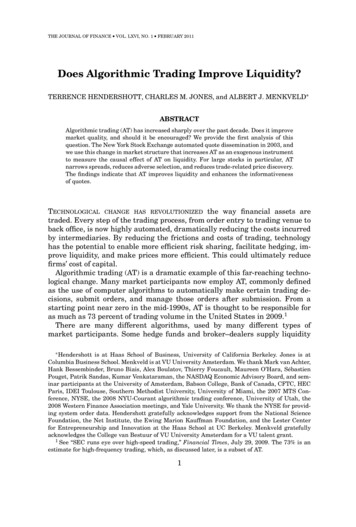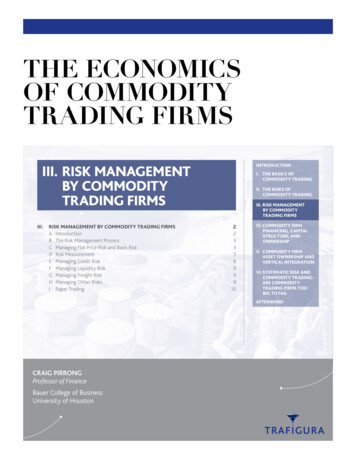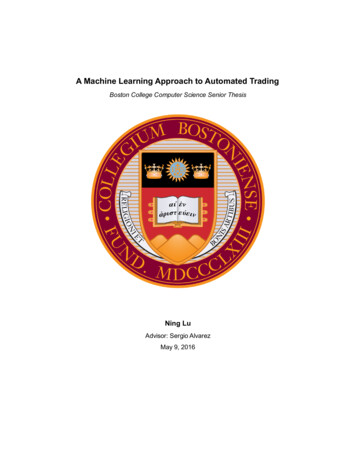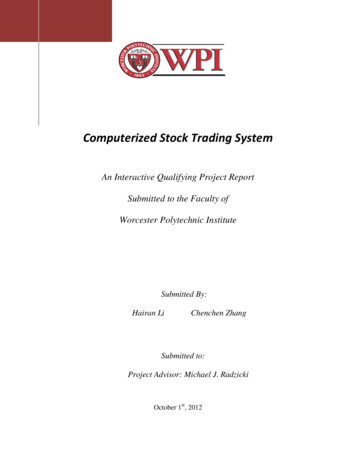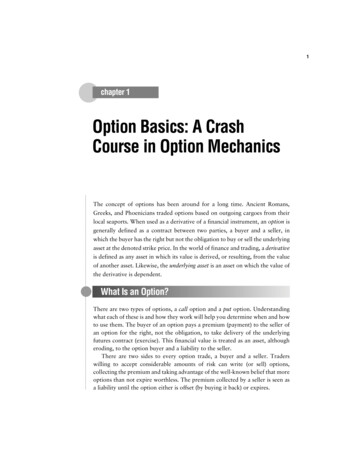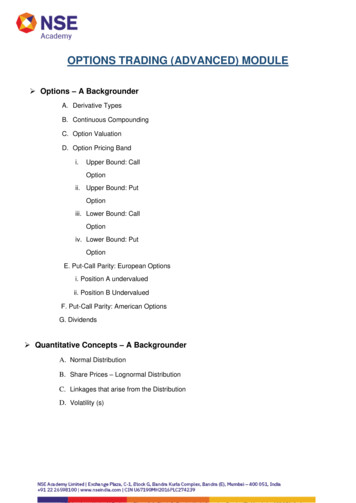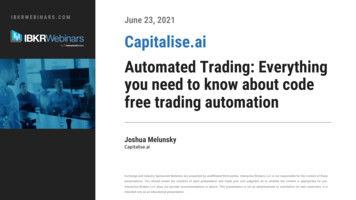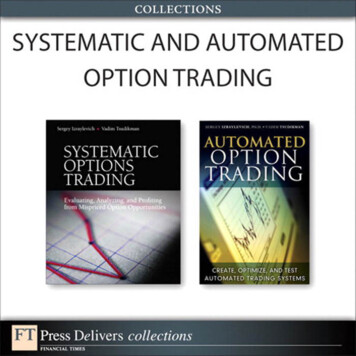
Transcription
SystematicOptions Trading
This page intentionally left blank
SystematicOptionsTradingEvaluating, Analyzing, and Profiting fromMispriced Option OpportunitiesSergey Izraylevich andVadim Tsudikman
Vice President, Publisher: Tim MooreAssociate Publisher and Director of Marketing: Amy NeidlingerExecutive Editor: Jim BoydEditorial Assistant: Pamela BolandOperations Manager: Gina KanouseSenior Marketing Manager: Julie PhiferPublicity Manager: Laura CzajaAssistant Marketing Manager: Megan ColvinCover Designer: Gary AdairManaging Editor: Kristy HartProject Editors: Jovana San Nicolas-Shirley and Andy BeasterCopy Editor: Apostrophe Editing ServicesProofreader: Williams Woods Publishing ServicesIndexer: Word Wise Publishing SrevicesSenior Compositor: Gloria SchurickManufacturing Buyer: Dan Uhrig 2011 by Pearson Education, Inc.Publishing as FT PressUpper Saddle River, New Jersey 07458This book is sold with the understanding that neither the authors nor the publisher is engaged in rendering legal, accounting, or otherprofessional services or advice by publishing this book. Each individual situation is unique. Thus, if legal or financial advice or otherexpert assistance is required in a specific situation, the services of a competent professional should be sought to ensure that the situationhas been evaluated carefully and appropriately. The author and the publisher disclaim any liability, loss, or risk resulting directly orindirectly, from the use or application of any of the contents of this book.FT Press offers excellent discounts on this book when ordered in quantity for bulk purchases or special sales. For more information, please contact U.S. Corporateand Government Sales, 1-800-382-3419, corpsales@pearsontechgroup.com. For sales outside the U.S., please contact International Sales atinternational@pearson.com.Company and product names mentioned herein are the trademarks or registered trademarks of their respective owners.All rights reserved. No part of this book may be reproduced, in any form or by any means, without permission in writing from the publisher.Printed in the United States of AmericaFirst Printing September 2010ISBN-10: 0-13-708549-4ISBN-13: 978-0-13-708549-1Pearson Education LTD.Pearson Education Australia PTY, Limited.Pearson Education Singapore, Pte. Ltd.Pearson Education North Asia, Ltd.Pearson Education Canada, Ltd.Pearson Educatión de Mexico, S.A. de C.V.Pearson Education—JapanPearson Education Malaysia, Pte. Ltd.Library of Congress Cataloging-in-Publication DataIzraylevich, Sergey, 1966Systematic options trading : evaluating, analyzing, and profiting from mispriced option opportunities / Sergey Izraylevich and Vadim Tsudikman.p. cm.ISBN-13: 978-0-13-708549-1 (hardback : alk. paper)ISBN-10: 0-13-708549-41. Stock options. 2. Options (Finance) 3. Investment analysis. 4. Portfolio management. I. Tsudikman, Vadim, 1965- II. Title.HG6042.I97 2011332.63’2283—dc222010006153
This book is dedicated to Professor Uri Gerson, Hebrew University of Jerusalem.
This page intentionally left blank
ContentsIntroduction . . . . . . . . . . . . . . . . . . . . . . . . . . . . . . . . xvPART Ichapter 1Criteria as the Basis of a Systematic ApproachGeneral Presentation and Review of Criteria Properties . . . 31.1 The Main Tool for Solving the Selection Problem . . . 31.2 Formal Definition . . . . . . . . . . . . . . . . . . . . . . . . . . . 41.3 Philosophy of Criteria Creation . . . . . . . . . . . . . . . . . 51.4 Mission Fulfilled by Criteria . . . . . . . . . . . . . . . . . . . . 61.5 Forecast as a Key Element of the Criterion . . . . . . . . . 81.6 Classification of Criteria . . . . . . . . . . . . . . . . . . . . . . . 91.6.1 Universal Criteria . . . . . . . . . . . . . . . . . . . . . . . . 91.6.2 Specific (Nonuniversal) Criteria . . . . . . . . . . . . 11chapter 2Review of the Main Criteria . . . . . . . . . . . . . . . . . . . . . 132.1 Criteria Based on Lognormal Distribution . . . . . . . . 132.1.1 Description of Lognormal Distribution. . . . . . 132.1.2 Expected Profit on the Basis of LognormalDistribution . . . . . . . . . . . . . . . . . . . . . . . . . . . . . . 152.1.3 Profit Probability on the Basis of LognormalDistribution . . . . . . . . . . . . . . . . . . . . . . . . . . . . . . 202.2 Criteria Based on Empirical Distribution . . . . . . . . . 222.2.1 Description of Empirical Distribution . . . . . . . . 222.2.2 Expected Profit on the Basis of EmpiricalDistribution . . . . . . . . . . . . . . . . . . . . . . . . . . . . . . 252.2.3 Profit Probability on the Basis of EmpiricalDistribution . . . . . . . . . . . . . . . . . . . . . . . . . . . . . . 28
viiiSystematic Options Trading2.2.4 Simplified Calculation Algorithm . . . . . . . . . . . 282.2.5 Modifications of Empirical Distribution . . . . . . 312.3 Criteria Based on the Ratio of ExpectedProfit to Loss . . . . . . . . . . . . . . . . . . . . . . . . . . . . . . . 342.3.1 Basic Concept and Criteria CalculationMethod . . . . . . . . . . . . . . . . . . . . . . . . . . . . . . . . . 342.3.2 Criteria Calculation Example . . . . . . . . . . . . . . 362.4 Criteria Based on Expert Distribution . . . . . . . . . . . 382.4.1 Basic Concept and Criteria CalculationMethod . . . . . . . . . . . . . . . . . . . . . . . . . . . . . . . . . 382.4.2 Set of Standard Distributions . . . . . . . . . . . . . . 392.4.3 Combining Separate Standard Distributionsinto a Unified Probability Density Function . . . . . . 452.4.4 Criteria Calculation on the Basis of the UnifiedProbability Density Function . . . . . . . . . . . . . . . . . 472.4.5 Construction and Valuation of ComplexStrategies Based on the Unified ProbabilityDensity Function . . . . . . . . . . . . . . . . . . . . . . . . . . 482.5 Specific (Nonuniversal) Criteria . . . . . . . . . . . . . . . . 502.5.1 Break-Even Range . . . . . . . . . . . . . . . . . . . . . . . 502.5.2 IV/HV Ratio . . . . . . . . . . . . . . . . . . . . . . . . . . . 532.5.3 Relative Frequency Criterion . . . . . . . . . . . . . . 572.5.4 The Ratio of Normalized Time Value to theCoefficient of Absolute Price ChangesDistribution . . . . . . . . . . . . . . . . . . . . . . . . . . . . . 58chapter 3Evaluation of Criteria Effectiveness . . . . . . . . . . . . . . . . 633.1 Introduction . . . . . . . . . . . . . . . . . . . . . . . . . . . . . . . 633.2 Methods of Criteria Effectiveness Evaluation . . . . . . 643.2.1 Correlation Between a Criterion andProfit as the Main Effectiveness Indicator . . . . . . . 643.2.2 Transformation of the Criteria EffectivenessIndicator . . . . . . . . . . . . . . . . . . . . . . . . . . . . . . . . 683.2.3 The Dynamics of Transformed EffectivenessIndicators . . . . . . . . . . . . . . . . . . . . . . . . . . . . . . . 693.2.4. Selection of the Averaging Period . . . . . . . . . . . 72
Contentsix3.3 Peculiarities of Criteria Effectiveness Evaluation . . . 753.3.1 Number of Combinations Used inthe Analysis . . . . . . . . . . . . . . . . . . . . . . . . . . . . . . 753.3.2 Expressing Profit . . . . . . . . . . . . . . . . . . . . . . . . 773.3.3 Expressing Effectiveness Indicators. . . . . . . . . 803.4 Review of Criteria Effectiveness Indicators . . . . . . . . 843.4.1 Correlation Between Criterion andProfit Values . . . . . . . . . . . . . . . . . . . . . . . . . . . . . 853.4.2 Correlation Between a Criterion andProfit Indexes . . . . . . . . . . . . . . . . . . . . . . . . . . . . 863.4.3 Correlation Between the Sharpe Ratios ofCriterion and Profit . . . . . . . . . . . . . . . . . . . . . . . . 883.4.4 Areas Ratio . . . . . . . . . . . . . . . . . . . . . . . . . . . . 913.4.5 Other Effectiveness Indicators . . . . . . . . . . . . . . 963.5 Summary . . . . . . . . . . . . . . . . . . . . . . . . . . . . . . . . 102PART IIchapter 4The Main Areas of Criteria ApplicationSelection of Option Combinations . . . . . . . . . . . . . . . . 1054.1 Introduction . . . . . . . . . . . . . . . . . . . . . . . . . . . . . . 1054.2 Analysis of Criteria Effectiveness in the Selectionof Option Combinations . . . . . . . . . . . . . . . . . . . . . 1064.3 Factors That Affect Option CombinationsSelection . . . . . . . . . . . . . . . . . . . . . . . . . . . . . . . . . 1104.3.1 Absolute Values of the Criterion . . . . . . . . . . . 1104.3.2 Strategy and Underlying Assets . . . . . . . . . . . . 1124.3.3 Simultaneous Analysis of Factors AffectingCombinations Selection . . . . . . . . . . . . . . . . . . . . 1134.4 Multistrategy, Long-Term Evaluation of CriteriaEffectiveness . . . . . . . . . . . . . . . . . . . . . . . . . . . . . . 1154.4.1 Methods . . . . . . . . . . . . . . . . . . . . . . . . . . . . . 1154.4.2 Results . . . . . . . . . . . . . . . . . . . . . . . . . . . . . . 1164.5 Summary . . . . . . . . . . . . . . . . . . . . . . . . . . . . . . . . 119chapter 5Selection of Option Strategies . . . . . . . . . . . . . . . . . . 1215.1 Introduction . . . . . . . . . . . . . . . . . . . . . . . . . . . . . . 1215.2 Evaluation of Criterion Effectiveness by RankingAnalysis . . . . . . . . . . . . . . . . . . . . . . . . . . . . . . . . . . 123
xSystematic Options Trading5.2.1 Methods of Ranking Analysis . . . . . . . . . . . . . 1235.2.2 Results of Ranking Analysis . . . . . . . . . . . . . . . 1315.2.3 Generalized Ranking Analysis andIntroduction of the Threshold Parameter . . . . . . . 1395.2.4 Results of Generalized Ranking Analysis . . . . . 1405.2.5 Maximum Obtainable Values of theCriterion Effectiveness Coefficient . . . . . . . . . . . . 1425.3 Traditional Methods of Evaluating the CriterionEffectiveness . . . . . . . . . . . . . . . . . . . . . . . . . . . . . . 1455.4 Synthetic Approach to Criterion EffectivenessAnalysis . . . . . . . . . . . . . . . . . . . . . . . . . . . . . . . . . . 1505.5 The Model for Optimizing the ThresholdParameter . . . . . . . . . . . . . . . . . . . . . . . . . . . . . . . . 1555.6 Summary . . . . . . . . . . . . . . . . . . . . . . . . . . . . . . . . 159chapter 6Selection of Underlying Assets . . . . . . . . . . . . . . . . . . 1616.1 Introduction . . . . . . . . . . . . . . . . . . . . . . . . . . . . . . 1616.2 Analysis of Criteria Effectiveness in Selectionof Underlying Assets . . . . . . . . . . . . . . . . . . . . . . . . . 1626.3 Multistrategy, Long-Term Evaluation ofCriteria Effectiveness . . . . . . . . . . . . . . . . . . . . . . . 1666.3.1 Methods . . . . . . . . . . . . . . . . . . . . . . . . . . . . . 1666.3.2 Results . . . . . . . . . . . . . . . . . . . . . . . . . . . . . . 1676.4 The Optimization Model for the Number ofUnderlying Assets . . . . . . . . . . . . . . . . . . . . . . . . . . . 1686.4.1 Utility Indicators . . . . . . . . . . . . . . . . . . . . . . . 1696.4.2 Utility Functions . . . . . . . . . . . . . . . . . . . . . . . 1716.4.3 Convolution of Utility Functions and DerivingOptima for Different Strategies and Criteria . . . . 1736.5 Summary . . . . . . . . . . . . . . . . . . . . . . . . . . . . . . . . 176
ContentsPART IIIchapter 7xiMulticriteria AnalysisBasic Concepts of Multicriteria Selection asApplied to Options . . . . . . . . . . . . . . . . . . . . . . . . . . 1817.1 Introduction . . . . . . . . . . . . . . . . . . . . . . . . . . . . . . 1817.2 The Pareto Set . . . . . . . . . . . . . . . . . . . . . . . . . . . . 1837.2.1 The Algorithm of Forming the Pareto Set. . . 1837.2.2 Widening the Pareto Set and the “Layer”Notion . . . . . . . . . . . . . . . . . . . . . . . . . . . . . . . . . 1867.3 Convolution . . . . . . . . . . . . . . . . . . . . . . . . . . . . . . 1907.4 Comparative Analysis of Multicriteria andMonocriterion Selection Effectiveness . . . . . . . . . . . 1917.5 Comparative Analysis of Two MulticriteriaSelection Methods: Pareto Versus Convolution . . . . 1977.6 Summary . . . . . . . . . . . . . . . . . . . . . . . . . . . . . . . . 202chapter 8The Impact of Criteria Correlation on MulticriteriaSelection . . . . . . . . . . . . . . . . . . . . . . . . . . . . . . . . 2058.1 Introduction . . . . . . . . . . . . . . . . . . . . . . . . . . . . . . 2058.2 Evaluation of Criteria Interrelationship . . . . . . . . . 2068.3 Criteria Correlation and Profitability of ParetoSelection . . . . . . . . . . . . . . . . . . . . . . . . . . . . . . . . . 2088.4 Criteria Correlation and Profitability ofSelection Using the Convolution Method . . . . . . . . . 2128.5 Summary . . . . . . . . . . . . . . . . . . . . . . . . . . . . . . . . 214Conclusion . . . . . . . . . . . . . . . . . . . . . . . . . . . . . . . 217Bibliography . . . . . . . . . . . . . . . . . . . . . . . . . . . . . . 219appendixBasic Notions . . . . . . . . . . . . . . . . . . . . . . . . . . . . . . 223Index . . . . . . . . . . . . . . . . . . . . . . . . . . . . . . . . . . . 235
This page intentionally left blank
xiiiAcknowledgmentsThe authors would like to express their gratitude to the team at High Technology Invest Inc.Special thanks are due to Arsen Balishyan, Ph.D., and Vladislav Leonov, Ph.D., for theirskillful assistance in research and manuscript preparation. We are also indebted to MikhailKolkovsky, Sergey Anikeev, and Eugen Masherov, Ph.D., for their useful comments andcontinued help at all stages of this project.
xivSystematic Options TradingAbout the AuthorsSergey Izraylevich, Ph.D., chairman of the board of High Technology Invest Inc., beganhis career as a lecturer at The Hebrew University of Jerusalem and Tel-Hay AcademicCollege. He received numerous awards for academic excellence, including Golda Meir’sprize and the Max Shlomiok honor award of distinction. Sergey has traded options formore than 10 years and engages in creating automated systems for the algorithmic tradingof options. He is the author of numerous articles published in highly rated, peer-reviewedscientific journals. Sergey is a columnist for Futures magazine.Vadim Tsudikman, president of High Technology Invest Inc., is a financial consultant andinvestment advisor specializing in derivatives valuation, hedging, and capital allocation inextreme market environments. With 12 years of options trading experience, he developscomplex trading systems based on multicriteria analyses and genetic optimizationalgorithms. In co-authorship with Sergey Izraylevich, Vadim contributes articles toFutures magazine on the cutting-edge issues related to options pricing, volatility, and riskmanagement.
xvIntroductionWhat the Book Is About and Who Should Read ItThis book discusses the procedures of multidimensional search, selection, and utilization ofpotential trading opportunities existing in the options market. It contains no magic rulespromising quick and guaranteed enrichment. Instead, you find comprehensive research aimedat discovery and practical application of statistical regularities and probabilistic characteristicsof option trading. The aim of our systematic approach is not the creation of ever-winningstrategies. Rather we strive to implement a realistic idea—developing a system of algorithmsand rules that provide you with statistical advantage over the average market participant. Thetrading system based on consistent application of the principles discussed in this book enablesyou to create and maintain positions with high (higher than the market average) expectedprofits and lower forecast risks.The substantial part of this book is devoted to the problem of selection. Statistical edge andprobabilistic advantages depend on our ability to select the best variants from a great numberof available alternatives. The options market is incredibly broad and diverse, whereaspromising trading opportunities are rare and hard to identify. To avoid missing the chance todiscover these scarce “pearls,” an ample quantity of alternatives should be thoroughlyestimated and analyzed. Continuous analyses of large data sets covering the entire optionsmarket is the only way to identify sparse trading opportunities that can be described as “thebest of the available ones.” Therefore, the issues related to the development, optimization,and practical application of selection criteria are discussed broadly and examined in depththroughout the book.This book is intended for you—traders, investors, portfolio managers, theoreticians, andeconomists—with different grounding level in options and mathematics.If you are familiar with the basics of statistics and probability theory and have masteredthe fundamentals of option trading, you can now proceed to reading this book. For those ofyou who have no previous experience with options but are familiar with the first two disciplines, we recommend you to start with the appendix in which we list the main definitionsand explain the notions and terms that are necessary to understand the contents of the book.Those who are not familiar with probability theory and statistics have two options. Youcan start reading without delving into proofs and arguments, focusing rather on patterns andregularities described in the text and on conclusions resulting from them. In this case you mustrely on the results presented by the authors and fully trust the validity of their judgments andconclusions. An alternative way, which is to dig into the basics of statistics and probability
xviSystematic Options Tradingtheory, can enable you to examine the material of the book critically. Even superficialknowledge of the basics of these subjects provides an opportunity to form your own opinionon many important issues of option trading. The first way can take less of your time andeffort, whereas the second one allows for getting the most out of this book.IntroductionHistory of options dates back thousands of years. Social and commercial relations governedby rules similar to option terms came into existence at the dawn of human society. Variousrecords are found in ancient documents and archeological sources dating back to the ages ofPentateuch. In Genesis Jacob purchased an option to marry Laban’s daughter Rachel inexchange for 7 years of labor. His prospective father-in-law, however, reneged, perhapsmaking this the first precedent of option default. Laban required Jacob to marry his olderdaughter Leah. Jacob obeyed his will, but because he loved Rachel, he purchased anotheroption requiring 7 more years of labor. He exercised the second option on the expirationdate and finally married his sweetheart.Before the early 1970s the options market was poorly organized. Most transactions wereexecuted over the counter, often through the mediation of banks or other financial institutions. Essential terms of trade were not standardized, and in each case they were establishedthrough negotiations of the parties concerned. There was no formal and objective pricingmechanism that could be used as the starting point to determine the option premium. Thewatershed point happened in 1973, when two events brought about a fundamental changein the financial world. This was the year when Fischer Black and Myron Scholes publishedtheir famous option pricing model (Black & Scholes, 1973) and the Chicago Board OptionsExchange (CBOE) began trading standardized option contracts. The first event providedtraders with a formalized algorithm of option pricing. Despite numerous drawbacks, thispricing model had one indisputable advantage: It enabled the comparison of market priceswith a benchmark value. The second event initiated the development of an organizedoptions market. This process is still underway today involving a growing number of investorsand financial flows in option trading.At the dawn of the new millennium, an important milestone in the development of theworld derivatives market was passed. For the first time the volume of exchange tradedoptions (having less than 30 years of history) exceeded the volume of futures traded since1848. Since then, options have been continuously dominating among other derivatives.The undisputed leader in option trading is the U.S. market that absorbs more than twothirds of the world trading volume. An important peculiarity of the U.S. options market isthe competition of many exchanges offering the same product (that is, options for the sameunderlying asset). Although CBOE surpasses other exchanges with regard to the volume oftraded contracts (approximately 30% of the total option trading volume), none of them
Introductioncontrols more than one-third of the market. Such a competitive environmentcontributes to liquidity growth, spread shortening, and commission declining thatattracts new market participants.The prospects of options market development are beyond any doubt. Every yearbrings in additional financial flows; new trading strategies evolve; and option-basedadvanced structured products become more and more popular. As time goes by, theinfluence of large institutional investors will strengthen. In the last several years hedgefunds became one of the dominating market drivers, and analysts forecast furtherinflow of their capital into the option trading. At the same time activity of individualinvestors on the derivatives markets is expected to become more intense.The area of options application is extremely wide. Mutual funds, banks, andinvestment companies use options as an instrument to regulate their investment risks.Buying Put options prevents financial institutions from liquidating long positionswhen they anticipate the underlying asset plunging. On the other hand, when marketgrowth is forecast, buying Call options limits potential losses (if the forecast fails) tothe premium paid for options. Buying options also creates considerable leverageadding to the investment potential and increasing the effectiveness of assetmanagement.Producers of various goods and consumers of raw materials use options to hedgethe risks of market price fluctuations. For example, by purchasing a Put option, an oilproducer ensures that its future output will be sold at a price not lower than the optionstrike price. This is the way the company can be secured against a possible fall in theprice of its production. On the other hand, an oil-refining company can buy a Calloption for oil, thereby ensuring that its raw material will be purchased at a price nothigher than the option strike price. Thus, the oil consumer can be secured against theprice growth. International companies can hedge currency risks of their export/importoperations by purchasing corresponding currency options.Use of options to manage risks is called hedging. Another area of applying options,often opposed to hedging, includes a class of speculative strategies aimed at earningprofits by creating various structures composed of long and short options.Speculative option strategies give investors broad opportunities incomparable withpossibilities provided by other financial instruments in respect to their flexibility andpotential profitability. The main feature of options distinguishing them from themajority of other financial instruments is the nonlinearity of their payoff function(which is the relationship between profit and the future underlying asset price). Thisfeature enables the creation of option combinations possessing almost any desiredprofit profile that makes options an indispensable instrument in achieving variousgoals for many financial market participants.This book is intended for investors who strive to make profits using speculativeoption trading. The principles described here can be applied to all option strategies.xvii
xviii Systematic Options TradingAlthough some of them are frequently used to demonstrate the techniques of discovering thetrading opportunities, whereas other strategies are not even mentioned, this selectivity ismerely due to our wish to keep the text within reasonable limits.The systematic approach presented in this book is based on universal principles that canbe applied to options on any type of underlying assets: stocks, futures, currencies, interestrates, and commodities. The same is true regarding different markets: Despite certainnational specificities in legislation and regulation terms, options markets of all countries aresuited for implementing the systematic approach.To illustrate the different aspects of the systematic approach and to demonstrate itspotential effectiveness in exploring the opportunities of option trading, we use historicaldata from U.S. exchanges. The research described in this book is based on a databasecontaining 7 years of price history of 2,500 stocks and their options.Options: What Is Known and What Is NotIn the 1980s, when the first option exchange and the first pricing model emerged, optionsmarkets began to develop so fast that the existing theoretical background could not satisfyincreasing practical needs. The facilities required to store and to process informationincoming from trading floors were not yet established. As a result, statistical data processingand theoretical developments could not satisfy growing demands of market professionals.However, as time goes by the stream of information grows and the scope of theoreticalresearch widens. Every year brings more and more professional publications on the subject.Options are thoroughly studied at universities, becoming one of the most popular topics ofeconomical, mathematical, and interdisciplinary research. Option exchanges arrangeseminars popularizing basic knowledge among beginners and organize advanced-levelcourses intended for market professionals.A significant bulk of knowledge on options has been accumulated. These attainments aresystematized and published in popular and professional sources. The literature on optionscan be divided into two main categories.The first category includes theoretical research on the basis of financial mathematics. Asubstantial number of scientific articles and books are devoted to the development ofadvanced option pricing models. They apply probability theory and discuss various complicated issues, including volatility abnormalities, nonlinearities, and interrelationshipsbetween parameters.A strict and extensive mathematical background of option theory is given by Peter James(James, 2003). This book represents the basis for researchers entering the world of options,though its complexity makes it comprehensible only to specialists with deep knowledge ofmathematics. The basics of derivatives theory are perfectly described by John Hull (Hull,
Introductionxix2008). This is a textbook that covers all essential issues from basic terminology to complicated problems of financial mathematics. Option pricing is widely discussed in Espen Haug’sbook (Haug, 2006). It can be used as a universal handbook covering up-to-date progress inprice modeling (see also Achdou and Pironneau, 2005, Rouah and Vainberg, 2007). Mathematical fundamentals of derivatives theory (not only options) are widely covered by SalihNeftci (Neftci, 2000). Although the majority of theoretical works have not yet been implemented, some of the mathematical models are widely used by option exchanges, brokers,market-makers, and traders. The ability to apply theoretical attainments becomes increasingly essential and publications dedicated to this issue gain considerable practical value(Reehl, 2007).Various aspects of volatility modeling and their implications on derivatives pricing werereviewed by Jim Gatheral and Nassim Taleb (Gatheral and Taleb, 2006). The authorsexamine all main properties of stochastic, local, and implied volatilities and describe manyclassical and advanced mathematical models. A special emphasis is placed on the dynamicproperties of the volatility surface and its relationship to options valuation. The discussionof volatility derivatives, barrier end exotic options is of particular interest. Besides this work,the theoretical problems of volatility modeling and forecasting were comprehensivelytreated by Ser-Huang Poon and Riccardo Rebonato (Poon, 2005, and Rebonato, 2004).The second category of publications is based on practical option trading and summarizesthe experience accumulated by market practitioners. It discusses strategies based oncombining different options and describes methods of building desirable profit profiles onthe basis of option positions structuring (Banks and Siegel, 2007, Cohen, 2005, Cohen,2009, Courtney, 2008, Vine, 2005). Strong emphasis is placed on methods of derivingarbitrage profit.Lawrence McMillan is a widely known author of popular books on options. His publications (McMillan, 2002; Lehman and McMillan, 2003) include a detailed description ofdifferent option strategies and are extremely useful. The author highlights a multitude ofversatile techniques indispensable for any option trader. Plentiful examples based on realmarket data, simple language, and broad coverage—those are the distinguishing features ofhis books. You can find not only an encyclopedic review of option strategies in McMillan’sbooks, but also a comprehensive description of delta-neutral hedging, arbitrage, and otherspecific techniques.An excellent example of a handbook covering most aspects of option trading is the workby Michael Thomsett (Thomsett, 2009). An option trader can find there a detaileddescription of many useful strategies. The problems of return calculation and risk evaluationare also discussed in detail. The author gives much attention to technical aspects of optiontrading—information sources, taxation, accounting for dividends, and so on.Books in which authors do not limit themselves to mere review of option strategies butdiscuss serious theoretical and practical issues without involving complicated mathematicsare also helpful.
xxSystematic Options TradingSheldon Natenberg (Natenberg, 1994, 2007) describes the key elements of option theoryin a popular and yet precise language. He discusses the peculiarities of implied volatilitybehavior and investigates the characteristics of the Greeks and specifics of their applicationas the instruments of risk analysis
Systematic options trading : evaluating, analyzing, and profiting from mispriced option opportunities / Sergey Izraylevich and Vadim Tsudikman. . more than 10 years and engages in creating automated systems for the algorithmic trading of options. He is the author of numerous articles published in highly rated, peer-reviewed
